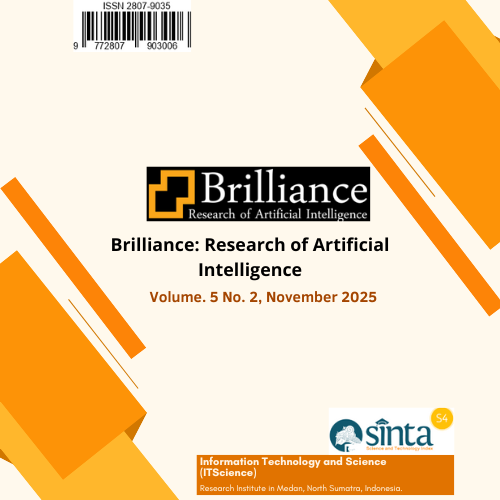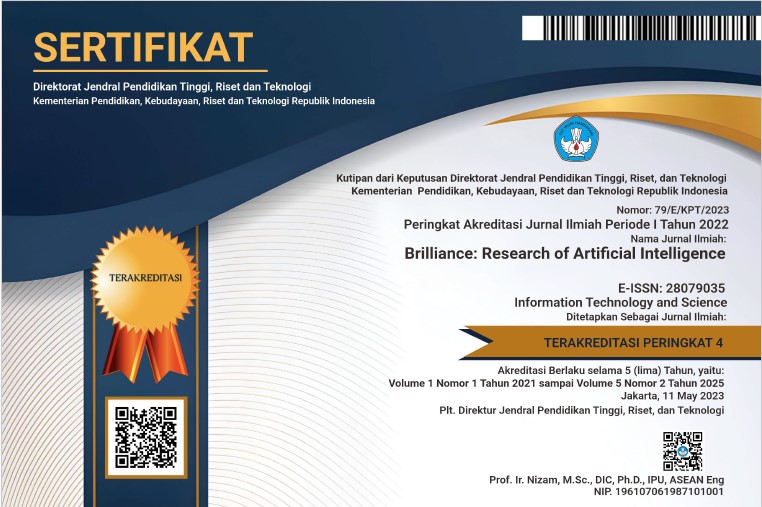Electronic Door App Development Using Machine Learning And Face ID
DOI:
https://doi.org/10.47709/brilliance.v5i2.6816Keywords:
Face ID, Smart_lock, Experimental, Waterfall, integrationAbstract
Face recognition technology (Face ID) has emerged as a highly secure solution by leveraging the distinctive attributes of each individual. The application of Face ID in electronic door access systems significantly enhances security across residential, commercial, and public facilities. This research's urgency can markedly enhance access security relative to traditional approaches and intelligent, secure, and efficient security solutions. The objective of the research is to create a Face ID-based door security system, enhancing efficiency and reliability in access security. The research employs the experimental technique alongside system development utilising the waterfall model. The process involves analysing requirements to facilitate research, followed by system design, system testing, and concluding with system implementation. Face ID employs artificial intelligence and machine learning technology to identify registered faces. The precision of facial detection with a high-resolution camera and its connection with a smart lock may be managed via the application. A biometric authentication system utilizing facial recognition can serve as a substitute for traditional door lock mechanisms. The main components of the electronic door include biometric recognition based on Face ID. Its mechanism uses a solenoid lock to automatically control the door lock through electromagnetic action. The user interface is equipped with an LCD screen, which displays comprehensive information about the status of the electronic door. The testing findings indicate that the input and output hardware of the system, specifically the camera and servo motor, function effectively.
References
A. F. Ibrahim, F. Dewanta, and, & S. Raniprima. (2022). Implementasi Machine Learning Pada Alat Deteksi Emosi Untuk Sistem Kontrol Suhu Dan Pencahayaan Ruangan Implementation Of Machine Learning In Emotion Detection Device For Room Temperature And Lightning Control Systems. E-Proceeding of Engineering, 9(2), 450–456.
Aini, Q., Lutfiani, N., Kusumah, H., & Zahran, M. S. (2021). Deteksi dan Pengenalan Objek Dengan Model Machine Learning: Model Yolo. CESS (Journal of Computer Engineering, System and Science), 6(2), 192. https://doi.org/10.24114/cess.v6i2.25840
Aris Oktafian. (2021). Merancang Pintu Pintar dengan Keamanan Multifungsi Berbasis IC AT-Mega 328. J-Eltrik, 2(2), 105. https://doi.org/10.30649/j-eltrik.v2i2.105
Danang, D., Fredyan, E., & Suasana, I. S. (2022). Prototype Alat Keamanan Rumah Internet Of Things (Iot) Berbasis Nodemcu Esp8266 Dengan Esp32 Cam Dan Kombinasi Sensor Menggunakan Telegram . Jurnal Universal Technic, 1(1), 1–9. https://journal.unimar-amni.ac.id/index.php/UNITECH/article/view/11
Desmira, D., Aribowo, D., Nugroho, W. D., & Sutarti, S. (2020). Penerapan Sensor Passive Infrared (Pir) Pada Pintu Otomatis Di Pt Lg Electronic Indonesia. PROSISKO: Jurnal Pengembangan Riset Dan Observasi Sistem Komputer, 7(1). https://doi.org/10.30656/prosisko.v7i1.2123
Fathur Rizky, R., Turmudi Zy, A., & Sunge, A. S. (2023). Sistem Smart Door Lock Menggunakan Voice Recognition Berbasis Arduino. Bulletin of Information Technology (BIT), 4(2), 239–244. https://doi.org/10.47065/bit.v4i2.696
Fauza, M., & Muthalib, M. A. (2022). Sistem Pengaman Pintu Otomatis Menggunakan Sensor Radio Frequency Identification (Rfid) Berbasis Arduino Uno. Jurnal Energi Elektrik, 11(1), 30. https://doi.org/10.29103/jee.v11i1.8185
Hovorushchenko, T., Aleksov, S., Ishtvan, E., Voichur, O., & Popov, P. (2023). Recognizing the Situations and Supporting the Decision-Making in the Residential Luminosity Control Subsystem of «Smart House» Cyber-Physical System. CEUR Workshop Proceedings, 3373, 566–588.
Kurniasih, W., Rakhman, A., & Salamah, I. (2021). Sistem Keamanan Jendela Rumah Berbasis IoT. Jurnal Riset Sistem Informasi Dan Teknik Informatika (JURASIK), 5(2), 2527–5771.
Kurniawan, A., Tama, A. P., Sunni, F., & Febrianto, R. (2021). Kunci Pintu Pintar Terintegrasi Digital “EASY LOCK.” Journal of Entrepreneurship, Management and Industry (JEMI), 4(2), 75–83. https://doi.org/10.36782/jemi.v4i2.1991
Kusuma, H. A., Wijaya, S. B., & Nusyirwan, D. (2023). Sistem Keamanan Rumah Berbasis Esp32-Cam Dan Telegram Sebagai Notifikasi. Infotronik?: Jurnal Teknologi Informasi Dan Elektronika, 8(1), 30. https://doi.org/10.32897/infotronik.2023.8.1.2291
Lestari, N. S., Herlina, Sukirno, Rahman, T., Wirjawan, A., & Hidayat, R. (2019). Development of E-Learning Application using Web-Based Tools to Improve Learning Effectiveness (Case Study: STT Mandala bandung). Journal of Physics: Conference Series, 1179(1), 012041. https://doi.org/10.1088/1742-6596/1179/1/012041
Lestari, N. S., Sukirno, Fadriani, H., Sujana, A., Herdiana, Y., & Hidayat, R. (2021). Design and Application Data-Based Employee Eat Barcode Scanner. Journal of Physics: Conference Series, 1764(1), 012065. https://doi.org/10.1088/1742-6596/1764/1/012065
Makanjuola, P. O., Shokenu, E. S., Araromi, H. O., Idowu, P. O., & Babatunde, J. D. (2022). An Rfid-Based Access Control System Using Electromagnetic Door Lock and an Intruder Alert System. Journal of Engineering Research and Reports, 22(11), 7–17. https://doi.org/10.9734/jerr/2022/v22i1117574
Martin, R. S., & Dewanto, Y. (2023). Prototipe kunci pintu otomatis menggunakan sensor kamera berbasis raspberry. Jurnal Teknologi IndustriM, 12(1), 21–29.
Pandey, S., Gupta, S., Saxena, S., & Tyagi, D. (2017). Smart Home Security System using IOT[1] S. Pandey, S. Gupta, S. Saxena, and D. Tyagi, “Smart Home Security System using IOT,” Int. Res. J. Eng. Technol., vol. 04, no. 11, pp. 1108–1112, 2019, [Online]. Available: https://doi.org/10.5281/zenodo.2709387#.Xd. International Research Journal of Engineering and Technology, 04(11), 1108–1112. https://doi.org/10.5281/zenodo.2709387#.XdejZgCEgAQ.mendeley
Prafanto, A., Budiman, E., Widagdo, P. P., Putra, G. M., & Wardhana, R. (2021). Pendeteksi Kehadiran menggunakan ESP32 untuk Sistem Pengunci Pintu Otomatis. JTT (Jurnal Teknologi Terapan), 7(1), 37. https://doi.org/10.31884/jtt.v7i1.318
Risaldo, B., Putra, A., Rohadi, E., & Ariyanto, R. (2016). Pengendalian Rumah Pintar Menggunakan Jaringan Internet Berbasis Raspberry Pi. Prosiding SENTIA, 8, 103–110.
Sekarsari, K. (2024). Sistem Keamanan Dua Lapis Pada Pintu Rumah Menggunakan RFID dan Pendeteksi Objek dengan Machine Learning. 6(2). https://doi.org/10.47065/bits.v6i2.5747
Setiawan, D., Jaya, H., Nurarif, S., Syahputra, T., & Syahril, M. (2022). Implementasi Esp32-Cam Dan Blynk Pada Wifi Door Lock System Menggunakanteknik Duplex. Journal of Science and Social Research, 5(1), 159. https://doi.org/10.54314/jssr.v5i1.807
Shams, E. A., & Rizaner, A. (2018). A novel support vector machine based intrusion detection system for mobile ad hoc networks. Wireless Networks, 24(5), 1821–1829. https://doi.org/10.1007/s11276-016-1439-0
Simatupang, J., & Tambunan, R. (2022). Security Door Lock Using Multi-Sensor System Based on RFID, Fingerprint, and Keypad. 453–457. https://doi.org/10.1109/GECOST55694.2022.10010367
Sumari, A. D. W., Annurroni, I., & Ayuningtyas, A. (2025). The Internet-of-Things-based Fishpond Security System Using NodeMCU ESP32-CAM Microcontroller. Jurnal RESTI, 9(1), 51–61. https://doi.org/10.29207/resti.v9i1.6033
Sungkar, M. S., Elektronika, T., Harapan, P., & Tegal, B. (2020). Gambar 1 . Flowchart Program. 9(2), 1–3.
Ulahaijananan, F. F. (2022). Jurnal Sosial dan Teknologi Terapan Amata Vol. 01 No. 2 (2022). 01(2), 1–5.
Yulita, W., & Afriansyah, A. (2022). Alat Pemantau Keamanan Rumah Berbasis Esp32-Cam. Jurnal Teknologi Dan Sistem Tertanam, 3(2), 2–10. https://doi.org/10.33365/jtst.v3i2.2197
Zainuddin, A. A., Daniel, A., Rahman, A., Nor, R. M., Aatief, A., Hussin, A., Nor, N., Saifudin, M., Mohd, N., Shamsudin, A. U., & Syariff, M. (2024). Innovative IoT Smart Lock System?: Enhancing Security with Fingerprint and RFID Technology. 4(4), 360–365.
Downloads
Published
How to Cite
Issue
Section
License
Copyright (c) 2025 Wisnu Hidayat, Ninik Sri Lestari, Dzulfikri Gammanr Gammanr

This work is licensed under a Creative Commons Attribution-NonCommercial 4.0 International License.


















